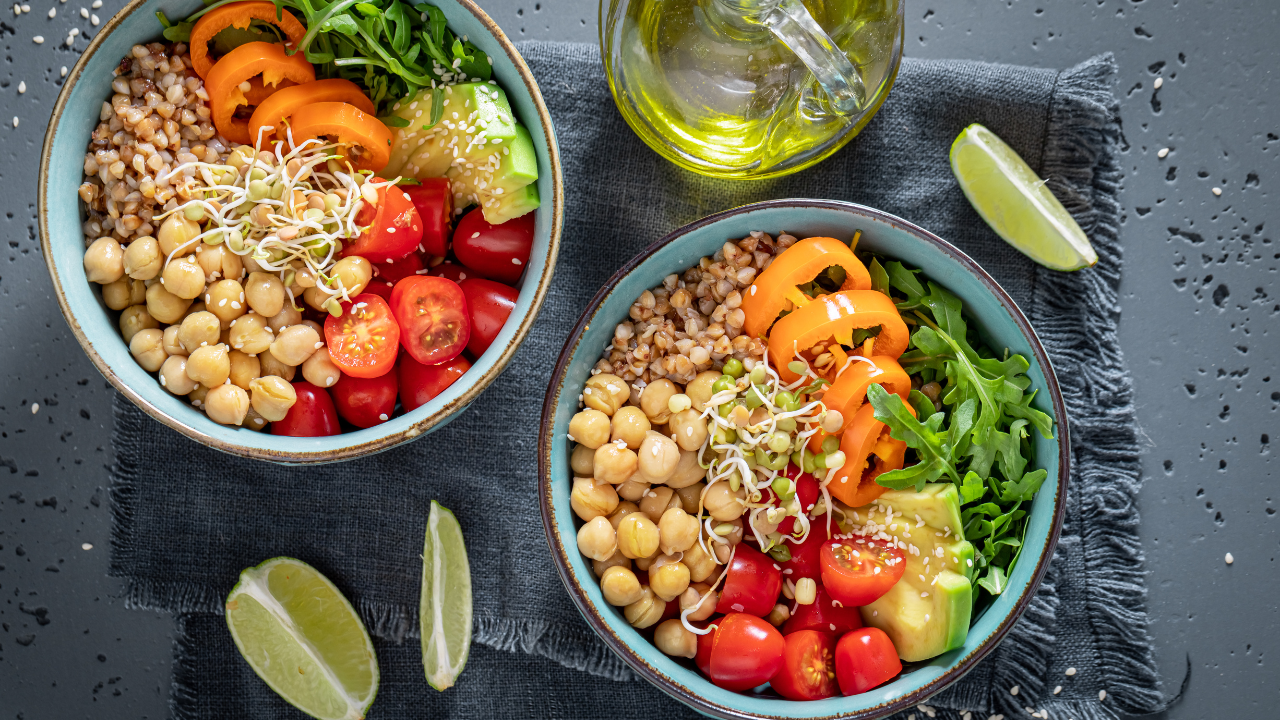How to Incorporate More Fruits and Vegetables With Intuitive Eating
As a dietitian, it’s not surprise that I get this question a lot - “how can I get more fruits and veggies in my diet?” We all know that fruits and vegetables are nutritious (well, unless you ask the carnivore diet folks), but unfortunately fruits and veggies have been hijacked by diet culture because they are generally low in calories.
You may have a complicated relationship with veggies because of your diet history. My personal example of this is that I used to think that I hated salads. But really, I just had a bad history with salads. I only ate the ones lowest in calories, used as little dressing as possible, and never added any fun ingredients to them. Of course I thought that I didn’t like them!
The best way to incorporate more produce into your diet with an intuitive eating approach is through gentle nutrition. Gentle nutrition is one of the 10 principles of intuitive eating and it involves taking health-promoting measures without the influence of diet culture. Contrary to popular belief, intuitive eating does not just mean eating pizza and donuts all day. In fact, intuitive eating has actually been associated with higher fruit and vegetable intake.
If you’re new here, hello and welcome! My name is Hannah and I am a non-diet dietitian here to help you improve your relationship with your food and finally find food freedom.
Benefits of eating more fruits and vegetables
Again, I don’t think I need to convince many people that produce is good for our health. But what are the benefits that come from eating more fruits and veggies?
More fiber
Fiber helps keep our digestive tract regular and it can also help reduce cholesterol levels. As a population, we aren’t eating enough fiber and increasing your intake of fruits and veggies could be one way to improve your fiber intake.
More vitamins and minerals
Fruits and vegetables are nutrient powerhouses. Whether canned, fresh, or frozen, veggies and fruit provide your body with a variety of vitamins and minerals. Different fruits and vegetables have different nutrient compositions, which is why it is important to eat a variety of produce. It can be fun to experiment and try new ones that you have never had before!
Better satisfaction at meals
Remember our friend fiber? Not only is fiber helpful for high-quality bowel movements, but it also helps us to stay fuller for longer.
But fiber is not the only factor in how satisfying our meals are. We can improve the satisfaction factor of our meals through various sensual qualities - taste, texture, colors, and temperatures. Incorporating veggies and fruit to our meals and snacks can really add to all of these senses.
How to incorporate fruits and veggies in a non-diet-y way
@dietitianhannah Let me know which food I should add to next 🧇🫐 #nutritionbyaddition #frozenwaffles #easybreakfast #dietitiantips #dietitianhannah #gentlenutrition #nutritiontips ♬ original sound - Dietitian Hannah
Think “addition” rather than “subtraction”
Nutrition by addition is one of my favorite ways to think about building balanced meals and snacks. When we consider what we can add to our life rather than what we feel should be taken away, we cultivate a mindset of abundance rather than restriction.
Instead of saying “I’m going to cut out carbs” or “I need to eat less at my meals”, perhaps shift your monologue to sound more like '“I am going to try adding fruit to my breakfast” or “How can I incorporate some veggies into this soup that I plan to make?”.
It’s important to note here that you don’t need to “eat the rainbow” at every meal and snack. Sometimes meals will be monochromatic, and that’s okay. All foods provide our body with nourishment, even those that don’t directly grow from the ground.
Experiment with different cooking methods
No more boring raw veggies (unless you like them this way). Air fry, roast, steam, and sauté your vegetables to change the texture of them (remember how I said different textures can make your meals more satisfying?). I also like to use different sauces and seasonings to add new flavor profiles to my vegetable dishes.
Take vegetables off of a pedestal
No more of the “good food” vs. “bad food” mentality. While it’s true that broccoli and brownies are not nutritionally equivalent, both can be incorporated in your life. You are not a bad person for eating brownies and a good person for eating broccoli. And when you are able to remove the moral value from food, you will be able to make choices that actually sound good instead of always just choosing the “healthy” option.
Focus on what you actually like about fruits and vegetables
No, not just that they are low calorie. What textures do you like? What types of flavors? Do you like the colors? What is your “why” for eating vegetables and fruit beyond the health benefits.
Incorporate veggies into your dishes
Veggies still “count” even when they aren’t just sitting alone on in a pile on your plate. Adding vegetables (or fruit) to your dishes will not only result in you eating more of them, but it can also make your meals taste even better.
Here’s a few ways I like to add veggies into every day meals and snacks
Add them to sandwiches. Some of my favorites are leafy greens, tomato, sprouts, onion, cucumber, peppers, and thinly sliced carrots.
Mix them into scrambled eggs. Add a salsa on top.
Use a fun dip for your veggies and fruit. I like to add ranch seasoning to plain Greek yogurt for a super easy and high protein veggie dip.
Throw them into starchy side dishes like pasta, mac and cheese, roasted potatoes, rice, etc. Peppers and onions can be easy additions to dishes like this.
Add canned, frozen, or fresh vegetables to soups.
Add veggies to homemade or frozen pizza.
A few other tips
Prep veggies right after you purchase them. Before putting them away, wash and shop any that you can. This will make you more likely to use them!
Try a new veggie every month. Make it fun. Look up recipes that feature these veggies. You could try kale, eggplant, turnips, okra, or other veggies that are “new” to you!
Bottom line
Adding fruits and veggies can absolutely be a part of an intuitive eating approach. With gentle nutrition (one of the principles of intuitive eating), adding these types of foods can be done in a non-diet-y way and increase your satisfaction of meals.
































